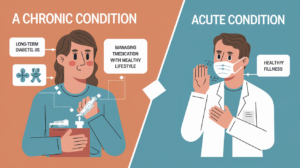Table of Contents
Chronic vs Acute Differences in terms of Chronic and Acute Medical Conditions
Difference Between Acute and Chronic Conditions
Acute conditions are defined as illnesses or medical events that have a rapid onset, are typically short-lived, and usually result from identifiable causes, such as infections, injuries, or sudden physiological imbalances. They often require immediate medical intervention to prevent complications and facilitate recovery. Chronic conditions are defined as diseases or disorders that develop slowly over time and persist for long durations, often for months or years. They are usually influenced by a combination of genetic, environmental, and lifestyle factors, and require ongoing management and treatment to control symptoms and prevent progression.
What Are the Causes of Acute and Chronic Conditions?
- Acute Causes:
- It often stems from infections (e.g., the common cold is frequently caused by a virus or an infection).
- Sudden injury events, such as falls or automobile accidents, can lead to intense pain and require prompt treatment.
- Overuse or trauma can result in a broken bone or a similar injury.
• Chronic Causes:
- Genetic predispositions and environmental exposures may gradually trigger the onset of chronic disease.
- Lifestyle factors, such as inadequate physical activity, overuse of alcohol, or excessive alcohol use, increase the risk of developing a chronic condition.
- Long-term stress or exposure to harmful stimuli contributes to conditions such as arthritis.
Acute on Chronic Causes:
- Instances where an initial acute condition exacerbates an existing chronic condition, sometimes described as “acute on chronic.”
What Are the Symptoms, and How Do You Treat Acute and Chronic Conditions?
- Symptoms of Acute Conditions:
- Sudden onset of pain.
- Swelling, fever, and signs of inflammation.
- Visible signs such as bruising from a sudden injury.
- Symptoms of Chronic Conditions:
- Persistent pain that might evolve into chronic pain syndromes.
- Gradual development of symptoms like fatigue or joint stiffness (common in arthritis).
- Ongoing discomfort that may slowly worsen over time.
Treatment Approaches
Treat acute medical condition
- Provide immediate intervention such as antibiotics or surgery.
- Administer treatments aimed at relieving symptoms quickly to promote rapid recovery.
- Offer emergency care for injuries or sudden infections.
Treatment For Chronic Conditions:
- Implement long-term management plans, including regular check-ups and lifestyle adjustments.
- Utilize therapies such as occupational therapy, acupuncture, meditation, and guided physical activity.
- Combine medications with preventive measures to mitigate episodes of flare-ups in longstanding conditions.
Common Symptoms
Rapid-Onset Conditions:
- Sudden pain, swelling, redness, and fever.
- Immediate, severe discomfort following an injury.
• Long-Term Conditions:
- Persistent pain and gradual symptom.
- Ongoing fatigue, stiffness, and joint pain (e.g., arthritis).
- Indicators that worsen over time if not managed properly.
Treatment Options For Acute and Chronic Illness
For Rapid-Onset Conditions:
- Quick, targeted treatments such as pain relievers, antibiotics, or surgery.
- Strategies to treat intense episodes and prevent complications.
For Persistent Illness:
- Long-term management involving lifestyle changes, regular medication, and continuous monitoring.
- Emphasis on sustained health through self-management and preventive measures.
- Use of physical therapies and alternative methods to reduce enduring pain.
Examples of Acute and Chronic Medical Conditions
Acute Conditions:
- Examples include a severe case of the common cold or a sudden injury.
- Events that trigger sudden pain and require prompt treatment.
Long-Term Conditions:
- Diseases such as arthritis, chronic kidney disease, and other conditions leading to persistent pain.
- Illnesses that often necessitate long-term management strategies.
Effects of High Blood Pressure
High blood pressure, or hypertension, is primarily considered a chronic condition because it develops and persists over an extended period. However, its effects can contribute to both acute and chronic medical issues. Here’s how it relates to these two categories:
- Chronic Impact:
- Long-Term Damage: Persistently high blood pressure can gradually damage blood vessels, the heart, kidneys, and eyes, leading to complications such as coronary artery disease, chronic kidney disease, or vision impairment.
- Progressive Nature: Over time, uncontrolled hypertension can worsen and contribute to other chronic conditions, such as heart failure or atherosclerosis.
- Acute Impact:
- Acute Episodes: Although high blood pressure is a chronic condition, sudden spikes (often termed hypertensive crises) can lead to immediate, life-threatening events such as a heart attack or stroke.
- Trigger for Acute Conditions: These abrupt increases in blood pressure may trigger acute conditions in patients with an underlying chronic hypertension diagnosis.
Why Self-Management for Chronic Conditions Matters
- Empowerment:
- When someone with a long-standing condition takes charge, they can minimize exacerbation risks.
- Lifestyle Adjustments:
- Incorporating physical activity, limiting sun exposure, and avoiding harmful substances can improve outcomes.
- Preventive Care:
- Early and regular clinical assessments and interventions are key to preventing sudden exacerbations of long-term conditions.
- Goals of Treatment:
- Establishing clear treatment goals helps manage persistent pain conditions.
Additional Interesting Information
Research Developments:
- Ongoing studies—some documented on a government website belonging to an official agency in the U.S.—highlight how rapid-onset conditions are often caused by infections or injuries.
- Advances in understanding how sudden pain might lead to a long-term state in vulnerable individuals.
Technological Innovations:
- New methods, including digital health tools, provide better tracking of these conditions.
- Innovations in medical interventions are improving recovery times for both rapid-onset and long-term conditions.
Preventive Strategies:
- Emphasis on early detection and treatment can prevent a new severe episode from developing into a prolonged condition.
- Education on the overuse of substances and the importance of physical activity is on the rise to support overall long-term health.
Understanding the Impact on Quality of Life
Both conditions can affect a patient’s quality of life. While an acute illness might temporarily disrupt daily activities, chronic conditions often have lasting impacts on physical, emotional, and social well-being. Comprehensive care—including timely treatment and ongoing management—is essential for maintaining overall health and quality of life.
Latest Research and Treatment Options
Rapid-Onset Medical Conditions:
- Innovations in emergency care and strategies have improved recovery outcomes.
- Enhanced surgical techniques and rapid response systems ensure effective treatment.
Long-Term Disease Management:
- Research at institutions like the University of Washington and the School of Medicine in WA is refining management techniques for persistent illnesses.
- The integration of personalized medicine and digital tools is advancing long-term healthcare.
Interdisciplinary Approaches:
- Collaboration among healthcare providers supports better treatment outcomes for both rapid-onset and long-term conditions.
Preventive Measures and Lifestyle Adjustments
For Both Conditions:
- Regular physical activity and balanced diets help mitigate health risks.
- Limiting sun exposure and avoiding excessive alcohol use reduce overall risk.
- Proactive measures, such as early medical intervention, prevent a severe flare-up in long-term conditions.
Lifestyle Recommendations:
- Patients are encouraged to engage in occupational therapy, acupuncture, meditation, and other supportive practices.
- Consistent monitoring and adjustments in daily routines can enhance overall health.
Conclusion
To sum up, the difference between rapid-onset and long-term conditions lies in their onset and duration. Rapid-onset conditions are marked by a sudden onset and require immediate care, while long-term conditions necessitate ongoing management.



